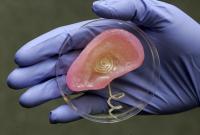Summary:
Scientists at Princeton
University used 3D printing of cells and nano particles followed by cell culture
to combine a small coil antenna with cartilage, creating what they term as a
bionic ear. The bionic ear is a functional ear that can hear radio frequencies way
beyond the range of a normal human.
 The 3D printers used computer-assisted
design to form objects as arrays of thin slices. The printer then made layers
of a variety of materials that range from plastic to cells to finish the
product. This allowed the researchers to combine the antenna electronics with
tissue within the highly complex topology of a human ear. They used a 3D
printer to combine a matrix of hydrogel and calf cells with silver nano particles that form an antenna. The calf cells later developed into cartilage.
The 3D printers used computer-assisted
design to form objects as arrays of thin slices. The printer then made layers
of a variety of materials that range from plastic to cells to finish the
product. This allowed the researchers to combine the antenna electronics with
tissue within the highly complex topology of a human ear. They used a 3D
printer to combine a matrix of hydrogel and calf cells with silver nano particles that form an antenna. The calf cells later developed into cartilage.NOS Themes:
- Science is subject to debate and tentative- The topic of creating organs through 3D printers has been debated for a long time on whether or not it is plausible.
- The role of skepticism- David Gracias, a professor at Johns Hopkins said that bridging the divide between biology and electronics represents a formidable challenge because the two things are very different. This leads people to think that creating organs through 3D printers does not seem probable.
- Science is collaborative- Different scientists, professors, and graduate students from Princeton, John Hopkins, and other colleges have done their individual experiments to put together what will truly work.
Article Link:
http://www.biologynews.net/archives/2013/05/01/printable_bionic_ear_melds_electronics_and_biology.html
Related Links:
- http://www.biologynews.net/archives/2005/01/25/university_of_manchester_makes_madetomeasure_skin_and_bones_a_reality_using_inkjet_printers.html
- http://www.biologynews.net/archives/2012/02/22/tiny_implantable_medical_device_can_propel_itself_through_bloodstream.html
- http://www.biologynews.net/archives/2012/02/29/nanofiber_breakthrough_holds_promise_for_medicine_and_microprocessors.html
This is really interesting. You see bionic people in movies all the times, but you never really believe it could come true. Do you think scientists could be able to create the first bionic being in a couple years from now? I read in the article linked below that they've come up with bionic eyes too.
ReplyDeletehttp://www.health-insurance-carriers.com/blog/health-cares-growing-cadre-of-bionic-beings/
I agree with Crystal! Can you imagine walking around with bionic beings in a couple decades? The world won;t be the same. There are so many different types of bionic body parts now, from arms to legs to eyes and ears. In this article, it shows a bionic man with all of the body parts. We are much closer to finding bionic beings than we think!
ReplyDeletehttp://www.dailymail.co.uk/sciencetech/article-2269824/Scientists-create-bionic-body-using-artificial-limbs-organs.html
I used to subscribe to a science magazine (Odyssey), and they had an entire issue dedicated to the concept of bionic technology (September 2010). It contained stories about numerous people who have arms replaced by machines, or basically any form of machinery that required the combination of technology and the human body.
ReplyDeleteWhat I do have to question, though, is Crystal and Lexi's use of the term 'bionic being'. Do you mean a person who has had all of their body parts replaced by machines? At what point would they stop being alive then? The key part of the word 'bionic' is 'bio', which means 'life'. If they were made entirely into robots, then we would no longer be in the realm of bionics and move into robotics.
However, if you are talking about beings who have had their body parts replaced by machines, I would have to argue that that had already happened. Depending on how lose your personal definition for bionics is, pacemakers could make someone into a bionic being. So could contacts, or artificial knees, protheses, or insulin pumps. Even arms that can be controlled using brain pulses have been developed and attached to humans. In the magazine I talked about earlier, I read about a blinded soldier who can now see partial images with his tongue. Lost hearing can be restored by cochlear implants in some people. Bionics is an emerging and fascinating field, so I guess we'll just have to how else we can combine body and machine in the following generations.
Additionally, here are some articles to look into:
The Future History of Bionic Tech
Modular Prosthetic Limb
Imagining a bionic future
I think it's really cool that it is possible to create something like this bionic ear. Two things I am really scared of are losing my sight or hearing so this makes me feel better. I wonder if this will start replacing hearing aids and how expensive they will be if they do start replacing hearing aids. This just proves that we are constantly creating new things that can help us live longer, which is cool but kind of weird at the same time.
ReplyDelete